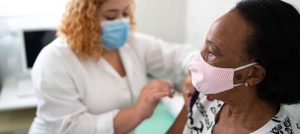Updated list: Medicare members to pay less for 43 drugs whose prices rose faster than inflation
CMS intends to send the first invoices in 2025 to manufacturers for the rebates owed to Medicare in 2023 and 2024.

Photo: Jose Luis Pelaez/Getty Images
The Centers for Medicare & Medicaid Services today released the list of 43 prescription drugs for which Medicare Part B beneficiaries' coinsurances may be lower, starting July 1 through September 30.
The drugs are, according to CMS:
- Abelcet
- Adcetris
- Aggrastat
- Akynzeo
- Atgam
- Aveed
- Bicillin CR
- Bicillin L-A
- Blincyto
- Carnitor
- Crysvita
- Cuvitru
- Cytogam
- Enjaymo
- Flebogamma DIF
- Folotyn
- Fragmin
- Gammagard S/D
- Gammaplex
- Humira
- Imlygic
- Infugen
- Kyprolis
- Leukine
- Lupron Depot-Ped
- Minocin
- Mononine
- Nipent
- NPlate
- Oncaspar
- Padcev
- Panhematin
- Prolia
- Rybrevant
- Signifor LAR
- Synribo
- Tezspire
- Trogarzo
- Vagomere
- Varizig
- Vectibix
- Vivitrol
- Xiaflex
As part of the Inflation Reduction Act, manufacturers are required to pay a rebate to Medicare if a drug's price increase exceeds the rate of inflation. CMS said it intends to send the first invoices in 2025 to manufacturers for the rebates owed to Medicare in 2023 and 2024.
Some people with Medicare Part B may pay lower coinsurance on 43 drugs, whose prices rose faster than the rate of inflation in a benchmark quarter. People who take these drugs may save between $1 and $449 per average dose between July 1 and September 30, depending on their individual coverage.
The Inflation Reduction Act also authorized Medicare to directly negotiate drug prices for select medications. Part B drugs may be eligible to be selected for negotiation starting in 2026 for prices effective in 2028.
WHY THIS MATTERS
New research from the Health and Human Services Office of the Assistant Secretary for Planning and Evaluation identified the major drivers of Medicare Part B drug spending between 2008 and 2021, such as its concentration among a small number of drugs, rapid spending growth on biologics, and spending on specialty drugs in oncology, ophthalmology, and rheumatology.
The top 20 drugs accounted for 53% of spending, while the top 10 accounted for 40% of Part B drug spending in 2021, according to the report.
Medicare Part B drug spending is largely driven by three medical specialties: ophthalmology, oncology and rheumatology. Drugs to treat cancer continued to account for the largest share of Part B drug program spending and accounted for over half of such spending in 2021.
THE LARGER TREND
The HHS report analyzed trends that have driven growth in spending for Medicare Part B coverage prior to passage of the Inflation Reduction Act.
Medicare Part B had the fastest rate of spending growth for drugs in the Medicare program prior to the IRA going into effect, HHS said.
Medicare Part B generally covers drugs provided in doctors' offices and hospital outpatient departments, while Medicare Part D drugs generally are purchased at the pharmacy counter or by mail order.
Other key points of the report include:
- Medicare fee-for-service Part B drug program spending in 2021 was $33 billion; that is about 27% of Medicare drug spending, 3.6% of total Medicare spending, and 6% of the nation's drug spending.
- Over the 2008-2021 period, Medicare Part B drug spending per enrollee grew on average at 9.2% annually. This spending growth was more than triple the rate in Part D at 2.6% and nearly four times as high as the rate of per capita annual prescription drug spending across all payers reflected in the National Health Expenditures Account (2.4 percent).
- Medicare spending on biologics has grown much more rapidly than spending on non-biologics over the past 13 years. From 2008 to 2021, spending growth on biologics accounted for nearly all (89%) of Medicare Part B drug spending growth. Biologics account for about 79% of Medicare FFS Part B prescription drug spending in 2021.
- Part B drug spending is shifting from physician offices to hospital outpatient departments: The share of Part B spending in this setting nearly doubled from 23% in 2008 to 41% in 2021, while the share of spending in physicians' offices declined from 63% to 53%.
- Among specific therapies, Part B spending on intravenous immuno-globulin (IVIG), and treatment for osteoporosis, rheumatoid arthritis, and cancer grew the most rapidly with an annual growth rate higher than 10% from 2008-2021.
ON THE RECORD
"Thanks to President Biden's new lower cost prescription drug law – the Inflation Reduction Act – manufacturers of qualifying drugs must pay rebates to Medicare if the price of those drugs increases at a rate faster than the rate of inflation," said HHS Secretary Xavier Becerra. "And Medicare now has the authority to negotiate lower prescription drug prices for the first time. The research announced today reinforces that President Biden's new law is helping control drug spending while making sure seniors and people with disabilities can afford the medications they need."
Twitter: @SusanJMorse
Email the writer: SMorse@himss.org












































